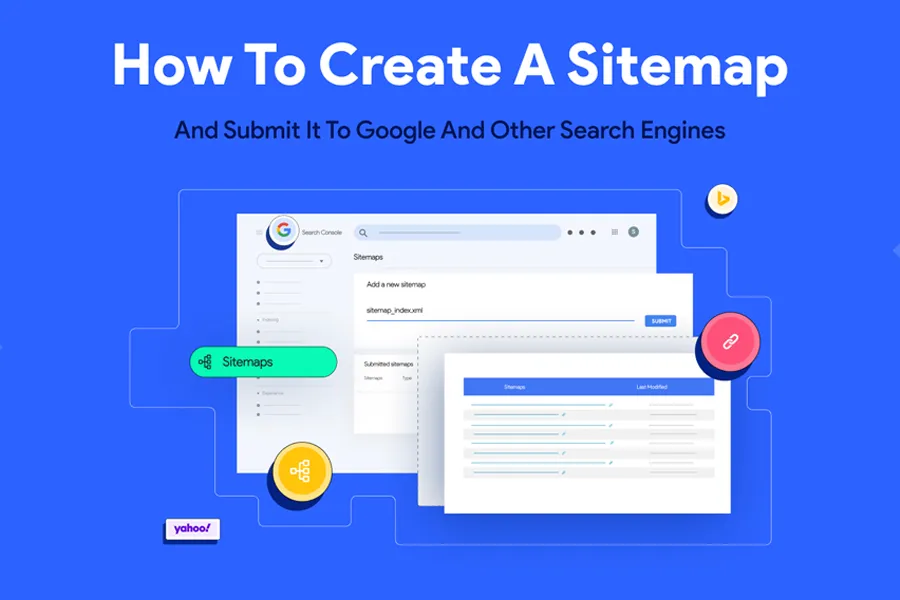
How to Create a Sitemap - Suffari
A sitemap is a crucial tool for website owners to enhance their site's visibility and navigation. It serves as a blueprint that helps search engines understand the structure of your website, ensuring all pages are easily discoverable. Creating an effective sitemap not only improves search engine optimization but also provides visitors with a clear path through your content. Understanding its importance is the first step toward building a well-organized and accessible website.
Table of Contents
How to Create a Sitemap - Suffari
Preparing to Create Your Sitemap
Assessing Your Website Structure
Deciding on the Sitemap Format
When to use more than 1 sitemap on a website?
Does Yoast also offer an html sitemap?
Tools Needed for Sitemap Creation
Optimizing Your Sitemap for SEO
Best Practices for Sitemap Submission
Updating Your Sitemap Regularly
Implementing Your Sitemap on Your Website
Uploading Files to Your Server
Adding Sitemap Links to Robots.txt
Verifying Sitemap Accessibility
What is a Sitemap?
A sitemap is a file that provides a roadmap of your website's structure, helping search engines and users navigate your content more efficiently. It lists all important pages, ensuring that no crucial information is overlooked during indexing or browsing.
The Importance of a Sitemap
Understanding the importance of a sitemap is crucial for effective website creation and management. A sitemap serves as a blueprint that helps search engines and users navigate your website easily, ensuring all important pages are accessible and indexed properly. It enhances the visibility of your site in search engine results, driving more traffic and improving overall SEO performance.
Benefits of Having a Sitemap
Having a sitemap offers numerous benefits, including faster indexing of new or updated content, better organization of your website structure, and improved user experience by providing clear navigation pathways. It also assists search engines in understanding the hierarchy and relationship between different pages, which can positively influence your site's ranking. Overall, creating a comprehensive sitemap is a vital step in building a successful, well-optimized website.
Types of Sitemaps
Creating a sitemap is a crucial step in the process of building a website, as it helps search engines understand the structure of your site and find all your pages efficiently. A well-organized sitemap improves SEO performance by ensuring that important pages are indexed correctly, enhancing visibility in search results. It also provides users with an overview of your website’s content, making navigation easier. There are different types of sitemaps designed to serve various purposes.
XML Sitemaps
XML sitemaps are primarily used for search engines; they list URLs along with metadata such as last modification date and priority, aiding in more effective crawling.
HTML Sitemaps
HTML sitemaps are user-focused and provide a page listing all or most pages on your site, helping visitors navigate easily.
Other Sitemaps
Additionally, there are image sitemaps to highlight visual content and video sitemaps to help search engines index multimedia content.
Selecting the right type of sitemap depends on your website’s content and your goals for SEO and user experience.
Preparing to Create Your Sitemap
Preparing to create your sitemap is a crucial step in optimizing your website for both users and search engines. Understanding the structure of your site and gathering essential information will help streamline the process. By planning ahead, you ensure that your sitemap accurately reflects your website’s content, making it easier for search engines to index your pages effectively.
Assessing Your Website Structure
Preparing to create a sitemap begins with thoroughly assessing your website's current structure. Understanding how your pages are organized helps ensure your sitemap accurately reflects your site’s hierarchy and content.
Review your website’s main navigation and subpages to identify primary sections and their relationships.
Make a list of all existing pages, including new, updated, or deleted ones.
Determine the importance and priority of each page to guide search engines on crawl preferences.
Check for broken links or orphaned pages that may need to be linked properly within the structure.
Use tools like site audits or analytics to analyze user flow and page performance, ensuring key pages are easily accessible.
Plan a logical hierarchy that groups related content together, facilitating easier navigation and better SEO.
Assessing your website structure thoroughly before creating a sitemap ensures it is comprehensive, accurate, and effective in helping search engines index your content properly.
Deciding on the Sitemap Format
Preparing to create your sitemap involves understanding the purpose of your website and planning its structure accordingly. This step helps ensure that your sitemap will effectively guide search engines and visitors through your site.
Determine the scope of your website by listing all major sections and pages.
Decide on the level of detail needed for your sitemap, whether it includes all pages or just key sections.
Gather information about your website’s hierarchy and URL structure to ensure accuracy.
When deciding on the sitemap format, consider your website's complexity and your target audience. Common formats include XML, HTML, and TXT.
XML Sitemaps: Ideal for search engines; they provide detailed information about each page, such as last modified date and priority.
HTML Sitemaps: Designed for human visitors; they help users navigate your website easily.
Text Files: Simple lists of URLs; suitable for basic submissions to search engines.
When to use more than 1 sitemap on a website?
If you’re designing your own website or optimizing an existing one around SEO best practices, the best way to please both Google and other search engines as well as your visitors and various crawlers on the web, is to use both an XML sitemap and an html sitemap. This is especially easy in WordPress when using an SEO plugin like AIOSEO which gives you both an XML and an html sitemap.
An XML Sitemap is best to keep in the background and submit to Google Search Console and an html sitemap is perfect to link inside your footer with the anchor text “Sitemap”. However, it’s not recommended to add a link to your xml sitemap in the footer.
Does Yoast also offer an html sitemap?
No. Just AIOSEO. Here’s how they each handle sitemaps.
AIOSEO vs Yoast for Sitemaps
Here’s how AIOSEO and Yoast SEO handle XML and HTML sitemaps:
✅ XML Sitemap
Both AIOSEO and Yoast SEO automatically generate an XML sitemap.
Yoast SEO
Automatically enabled upon activation.
Accessible at: yourdomain.com/sitemap_index.xml
Includes posts, pages, categories, tags, and custom post types.
All in One SEO (AIOSEO)
Also auto-generates an XML sitemap.
Accessible at: yourdomain.com/sitemap.xml
Offers more granular control over what’s included (e.g., taxonomies, authors, etc.).
❌ HTML Sitemap
Only AIOSEO includes an HTML sitemap feature by default.
AIOSEO
✅ Has built-in HTML sitemap functionality.
Can be added via a shortcode ([aioseo_html_sitemap]) or Gutenberg block.
You can customize which post types or taxonomies are displayed.
Yoast SEO
❌ Does NOT include an HTML sitemap.
You would need a separate plugin or custom code to create one manually.
Tools Needed for Sitemap Creation
Preparing to create your sitemap involves understanding the structure and content of your website, as well as selecting the appropriate tools to facilitate the process. Before starting, gather all relevant information about your site's pages, hierarchy, and URLs to ensure a comprehensive sitemap. This preparation helps in creating an accurate and effective sitemap that improves your website’s SEO and user navigation.
Tools needed for sitemap creation include online sitemap generators, desktop software, or manual methods. Online tools like XML-Sitemaps.com or Screaming Frog provide automated options for generating sitemaps quickly. WordPress SEO plugins like Yoast SEO or AIOSEO can also be used for more control and convenience as they automatically create sitemaps for you and keep them updated with new content additions and revisions. Additionally, simple text editors like Notepad are useful if you prefer to create sitemaps manually by coding XML files. Selecting the right tool depends on the size of your website, technical skill level, and specific requirements.
Creating an XML Sitemap
Creating an XML sitemap is an essential step for website owners looking to improve their site's visibility and indexing on search engines. A sitemap serves as a roadmap, helping search engines understand the structure of your website and discover all your important pages. In this article, we will explore the process of creating an effective XML sitemap to enhance your website's SEO performance.
Manual Creation Process
Creating an XML sitemap manually involves several steps to ensure your website's pages are properly indexed by search engines. First, open a plain text editor like Notepad or any code editor of your choice. Then, start by writing the XML declaration at the top: <?xml version="1.0" encoding="UTF-8" ?>. Next, create the root element <urlset> and specify the namespace attribute as "http://www.sitemaps.org/schemas/sitemap/0.9". Inside the <urlset> tag, add individual <url> elements for each page you want to include. Within each <url>, specify the <loc> (the URL of the page), <lastmod> (the date when the page was last modified), <changefreq> (how frequently the page is updated), and <priority> (the importance of the page relative to others). Be sure to use the correct date format (YYYY-MM-DD) in the <lastmod> field. After listing all your pages, close the </urlset> tag and save the file with a .xml extension, such as sitemap.xml. Finally, upload this sitemap file to the root directory of your website and submit its URL to search engines like Google Search Console to enhance your site's visibility and indexing.
Using Sitemap Generator Tools
Creating an XML sitemap is an essential step in improving your website's SEO and ensuring that search engines can efficiently crawl and index your content. Using sitemap generator tools simplifies this process by automatically creating a structured list of all your web pages.
To create an XML sitemap using sitemap generator tools, follow these steps:
Select a reliable sitemap generator tool such as XML-Sitemaps.com, Screaming Frog, or Yoast SEO if you use WordPress.
Enter your website URL into the tool's input field to start the scanning process.
The tool will analyze your site and generate a comprehensive sitemap that includes all important pages.
Review the generated sitemap for accuracy and completeness. Make any necessary adjustments if the tool allows customization.
Download the XML sitemap file to your computer.
Upload the sitemap file to your website's root directory via FTP or your hosting control panel.
Submit the sitemap URL to search engines like Google Search Console and Bing Webmaster Tools to facilitate indexing.
Using sitemap generator tools makes it straightforward to create and manage your XML sitemap, enhancing your site's visibility and search engine performance.
Validating Your XML Sitemap
Creating an XML sitemap is an essential step in optimizing your website for search engines. To create one, you can manually write the XML code or use tools and plugins that generate sitemaps automatically. Ensure that your sitemap includes all important pages, such as homepage, category pages, and blog posts, with accurate URLs and last modified dates. Once completed, save the file with a .xml extension and upload it to your website's root directory.
Validating your XML sitemap is crucial to ensure it's correctly formatted and accessible to search engines. You can use online validation tools like XML Sitemap Validator or XML Sitemap Checkers to identify any errors or issues. Additionally, you should test the sitemap by submitting it to search engine webmaster tools, such as Google Search Console, which provide feedback on its validity and indexing status. Regular validation helps maintain your sitemap's accuracy and improves your site's SEO performance.
Creating an HTML Sitemap
Creating an HTML sitemap is an essential step in organizing your website's structure and improving user navigation. It provides a clear overview of all the pages on your site, making it easier for visitors to find what they need. In this guide, we will walk you through the process of building a simple and effective HTML sitemap to enhance your website's usability and accessibility.
Designing the HTML Structure
Creating an HTML sitemap involves designing a structured page that helps visitors easily navigate your website. Start by planning the main sections of your site, such as Home, About Us, Services, and Contact. Use headings to organize these sections clearly. Within each section, list relevant pages using unordered or ordered lists to enhance readability. Ensure that links are descriptive so users understand where they will go when clicked. Keep the structure simple and logical, grouping related pages together. Use nested lists if there are subpages under main categories. Incorporate a clear hierarchy to guide users through your content seamlessly. Avoid unnecessary attributes and focus on a clean layout that aligns with your website’s design. Regularly update your HTML sitemap to reflect any changes or additions to your site’s content. Overall, a well-structured HTML sitemap improves user experience and helps search engines crawl your website effectively.
Adding Links to All Pages
Creating an HTML sitemap involves organizing and listing all the pages of your website in a structured manner to help visitors navigate easily. To begin, open a new HTML file and use the tag to introduce your sitemap with a brief description. Next, create a list of links to each page on your website using nested tags for clarity. For each page, add a line with the page name followed by a link to that page, using the tag without any attributes. Ensure that every page you want to include is linked properly so users can find all sections of your site effortlessly. Remember to update your sitemap regularly as your website grows or changes. This simple structure not only improves user experience but also aids search engines in indexing your site's content effectively. By maintaining a clear and comprehensive HTML sitemap, you enhance your website’s navigation and accessibility for all visitors.
Ensuring Easy Navigation
Creating an HTML sitemap is essential for enhancing website navigation and improving user experience. To begin, organize your website’s content into logical categories and lists. Use unordered lists to group related pages and list items for individual links, making the structure clear and easy to follow. Include all important pages such as Home, About, Services, Contact, and any other relevant sections. Ensure that each link is descriptive so visitors understand where they will be directed. Keep the sitemap simple and accessible, avoiding clutter or unnecessary details. Regularly update the sitemap to reflect any changes or additions to your website content. By maintaining a well-structured HTML sitemap, you help users find information quickly and improve overall site usability, contributing positively to search engine indexing.
Optimizing Your Sitemap for SEO
Creating an effective sitemap is a crucial step in optimizing your website for search engines. A well-structured sitemap helps search engines discover and index your pages more efficiently, ensuring that your content reaches a wider audience. By understanding the best practices for designing and submitting your sitemap, you can significantly enhance your site's SEO performance and improve overall visibility online.
Best Practices for Sitemap Submission
Optimizing your sitemap for SEO is essential to ensure search engines can efficiently crawl and index your website's content. Start by including only high-quality, relevant URLs that you want to rank in search results. Use a clear hierarchy and organize pages logically to help search engines understand your site's structure better. Keep your sitemap up-to-date by regularly adding new content and removing outdated or deleted pages. Compress your sitemap files using gzip to reduce load times and server bandwidth. Additionally, use a sitemap index file if you have multiple sitemaps to manage larger websites effectively.
When submitting your sitemap, choose the appropriate platform such as Google Search Console and Bing Webmaster Tools. Submit your sitemap URL directly within these tools to facilitate faster indexing. Ensure that your sitemap is accessible and correctly formatted, typically in XML format, and free of errors. Monitor the submission process to identify and fix any issues reported by search engines. Regularly update your sitemap submission to reflect changes on your website, which helps improve your SEO performance and ensures all valuable pages are discoverable by search engines.
Submitting to Search Engines
Creating an effective sitemap is essential for optimizing your website for search engines. It helps search engines understand the structure of your site and discover all your pages efficiently. Start by designing a clear and organized sitemap that includes all important pages, ensuring that your most valuable content is easily accessible. Use a standard XML format, which is compatible with most search engines, and regularly update your sitemap to reflect any changes or additions to your website. Including metadata such as last modification date and priority can enhance crawling efficiency. Once your sitemap is ready, submit it to search engines like Google and Bing through their webmaster tools or search console platforms. This process ensures fast indexing and better visibility of your website in search results. Remember to keep your sitemap clean and free of errors to maximize its SEO benefits and improve your site's overall search engine performance.
Updating Your Sitemap Regularly
Optimizing your sitemap for SEO is essential to ensure that search engines can efficiently crawl and index your website. Start by including all important pages, such as your homepage, product pages, blog posts, and contact information, to maximize visibility. Use a clear and organized structure, prioritizing high-value content to help search engines understand the hierarchy of your site. Incorporate relevant keywords in your sitemap to enhance SEO relevance. Additionally, keep your sitemap clean and free of broken links or outdated URLs to improve crawling efficiency.
Updating your sitemap regularly is crucial as it reflects the current state of your website. Whenever you add new content, remove outdated pages, or make significant changes, update your sitemap accordingly. This proactive approach ensures that search engines are aware of your latest updates, leading to faster indexing and improved search rankings. Submit your updated sitemap to search engines like Google Search Console and Bing Webmaster Tools to facilitate prompt crawling. Consistently maintaining and updating your sitemap helps sustain your site's SEO health and visibility over time.
Implementing Your Sitemap on Your Website
Creating and implementing a sitemap is an essential step in optimizing your website for search engines and enhancing user navigation. A well-structured sitemap helps search engines understand the organization of your content, ensuring that all important pages are indexed effectively. Additionally, it provides visitors with an overview of your site’s structure, making it easier to find information quickly. In this article, we will explore simple steps to create and implement an effective sitemap for your website.
Uploading Files to Your Server
Implementing your sitemap on your website is a crucial step to ensure search engines can easily discover and index all your pages. Start by creating an XML sitemap file that lists the URLs of your website, including relevant metadata such as last modified date, change frequency, and priority. Once your sitemap file is ready, upload it to the root directory of your web server using an FTP client or your hosting control panel. Ensure the file is accessible at the standard location, typically www.yourwebsite.com/sitemap.xml. After uploading, submit your sitemap to search engines like Google Search Console and Bing Webmaster Tools to enhance your site's visibility and indexing efficiency. Regularly update your sitemap whenever you add or remove pages from your website to keep search engines informed about your site’s structure. This process helps improve your website's SEO and ensures all your content is properly indexed.
Adding Sitemap Links to Robots.txt
Implementing your sitemap on your website is a vital step to ensure that search engines can easily discover and index all your pages. To do this, first generate an XML sitemap that lists all the important URLs of your site, including their last update times and priority levels. Once your sitemap is ready, upload it to your website's root directory so it can be accessed via a URL like www.yoursite.com/sitemap.xml. Next, add a reference to this sitemap in your robots.txt file by including a line such as "Sitemap: www.yoursite.com/sitemap.xml". This helps search engines find your sitemap automatically when they crawl your site. Regularly update your sitemap whenever you add or remove pages to keep search engines informed about your site's structure. Proper implementation of your sitemap improves indexing efficiency and boosts your site's visibility in search results.
Verifying Sitemap Accessibility
To implement your sitemap on your website, start by uploading the sitemap file to your web server, typically placed in the root directory. Then, ensure that the URL of your sitemap is accessible by visiting it directly through your browser. Verifying sitemap accessibility involves checking that the sitemap can be retrieved without errors and that its URL is correctly submitted to search engines like Google Search Console or Bing Webmaster Tools. This verification helps search engines crawl your website more effectively and ensures your pages are indexed properly.
Monitoring and Maintaining Your Sitemap
Monitoring and maintaining your sitemap is a crucial step in ensuring that your website remains optimized for search engines. Regular updates help search engines crawl your site efficiently, capturing new content and fixing any errors. By actively managing your sitemap, you can improve your site's visibility, enhance user experience, and ensure that your website's structure is accurately represented to search engines.
Checking for Errors
Monitoring and maintaining your sitemap is essential to ensure that search engines can effectively crawl and index your website. Regularly review your sitemap for any broken links or outdated URLs to keep it accurate and up-to-date. Use tools like Google Search Console to check for errors or warnings related to your sitemap, such as submission issues or indexing problems. Promptly fix any detected errors by updating or removing incorrect entries, and resubmit the updated sitemap to search engines. This ongoing process helps improve your site's visibility and ensures that new content is promptly discovered and indexed.
Updating for Website Changes
Monitoring and maintaining your sitemap is essential to ensure it accurately reflects the current structure of your website. Regularly review your sitemap for broken links, outdated pages, or any changes in URLs. Updates should be made promptly whenever you add, delete, or modify pages on your site to keep search engines informed. Submitting the revised sitemap to search engines like Google and Bing helps improve your site's indexing and visibility. Using tools such as Google Search Console can assist in monitoring crawl errors and performance issues related to your sitemap. Consistent maintenance not only enhances SEO but also provides a better experience for your visitors by ensuring they find up-to-date content.
Using Analytics to Improve Site Structure
Monitoring and maintaining your sitemap is essential to ensure it accurately reflects your website's current structure and helps search engines crawl your content effectively. Regularly review your sitemap for outdated or broken links and update it whenever you add or remove pages. Keeping your sitemap clean and up-to-date improves indexing efficiency and enhances your site's visibility.
Using analytics to improve your site structure involves analyzing user behavior, popular pages, and navigation paths. By understanding how visitors interact with your website, you can identify areas that need better organization or additional internal links. Incorporate these insights to refine your sitemap, making it more intuitive for both users and search engines, which ultimately boosts your site's SEO performance.























Youtube